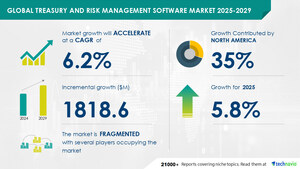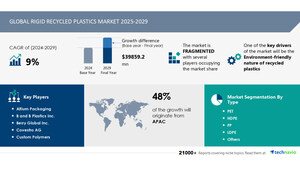NEW YORK, Sept. 6, 2024 /PRNewswire/ -- Report with the AI impact on market trends- The global sensor market size is estimated to grow by USD 422.7 billion from 2024-2028, according to Technavio. The market is estimated to grow at a CAGR of 21.92% during the forecast period. Rise in demand for IoT technology-based devices is driving market growth, with a trend towards rise in adoption of wearable devic. However, increasing usage of network-embedded systems poses a challenge. Key market players include ABB Ltd., Amphenol Corp., ams OSRAM AG, Dwyer Instruments Inc., Honeywell International Inc., Infineon Technologies AG, Johnson Controls International Plc, Microchip Technology Inc., NXP Semiconductors N.V., OMRON Corp., Panasonic Holdings Corp., Qualcomm Inc., Robert Bosch GmbH, Rockwell Automation Inc., Siemens AG, Sony Group Corp., Spectris Plc, STMicroelectronics International N.V., TE Connectivity Ltd., and Texas Instruments Inc..
Key insights into market evolution with AI-powered analysis. Explore trends, segmentation, and growth drivers- View the snapshot of this report
Sensor Market Scope |
|
Report Coverage |
Details |
Base year |
2023 |
Historic period |
2018 - 2022 |
Forecast period |
2024-2028 |
Growth momentum & CAGR |
Accelerate at a CAGR of 21.92% |
Market growth 2024-2028 |
USD 422.7 billion |
Market structure |
Fragmented |
YoY growth 2022-2023 (%) |
17.71 |
Regional analysis |
North America, APAC, Europe, Middle East and Africa, and South America |
Performing market contribution |
North America at 39% |
Key countries |
US, China, Japan, Germany, and France |
Key companies profiled |
ABB Ltd., Amphenol Corp., ams OSRAM AG, Dwyer Instruments Inc., Honeywell International Inc., Infineon Technologies AG, Johnson Controls International Plc, Microchip Technology Inc., NXP Semiconductors N.V., OMRON Corp., Panasonic Holdings Corp., Qualcomm Inc., Robert Bosch GmbH, Rockwell Automation Inc., Siemens AG, Sony Group Corp., Spectris Plc, STMicroelectronics International N.V., TE Connectivity Ltd., and Texas Instruments Inc. |
Wearable gadgets, including smartwatches, smart bands, and headsets, have become increasingly popular in the consumer electronics industry. These devices, which are designed to be worn on the body, offer intelligent operation capabilities. In the healthcare sector, wearable electronics featuring sensors have gained significant traction, particularly in developing economies. Sensors, such as those found in fitness trackers, pulse oximeters, and medical-grade wearables, provide real-time health monitoring solutions with benefits like high accuracy, compact size, and resistance to electromagnetic radiation. The global sensor market is poised for growth due to the rising adoption of these devices.
The sensor market is thriving with innovative technologies like Humidity sensor tech, led by Molybdenum sulfide (MoS2), reducing detection time. Sensor components such as microcontrollers, transceivers, amplifiers, ADC & DAC, and NEMS are key players. Industries like Industrial IT & telecom, Aerospace & defense, and Consumer electronics are major consumers. Trends include Luna Ring tech for noise reduction, Glucowear for healthcare, Sensirion for surveillance cameras, and RFID sensors for retail. NEMS sensors in IT/telecom, industrial sector, and aerospace & defense sector are game-changers. Smart devices, healthcare, security, automotive, and industrial sensors market are growing. Smartphone OEMs and biomedical applications use MEMS technology-based sensors. Weather forecast systems and IoT platforms also leverage sensor tech.
Request Sample of our comprehensive report now to stay ahead in the AI-driven market evolution!
• Embedded networking, a result of digital telecommunications advancements, connects embedded systems through network architecture, topology, hardware devices, and communication protocols. Embedded systems offer wired and wireless communication options for integrating networking features into devices. These systems are utilized in various smart gadgets and electronic goods, forming part of wireless sensing networks. However, adding sensors to devices increases cost and shortens their lifespan, which may limit the growth of the global sensor market during the forecast period.
• The sensor market is experiencing significant growth due to the increasing demand for remote connectivity in various industries. Key sectors include automotive and industrial, where applications range from airbags and side airbags in motor vehicles to automated intelligent controls in manufacturing. The rise of electric vehicles and IoT-connected devices is driving the need for wireless networks, analytics solutions, and communication networks for remote monitoring. In the automotive sector, sensors like image sensors, radar sensors, and biosensors are crucial for security & surveillance and autonomous driving. The industrial sector relies on pressure sensors, temperature sensors, and humidity sensors for process control and optimization. Wearable electronics, medical equipment, and transportation & logistics sectors also contribute to the sensor market revenue. Challenges include ensuring reliable remote connectivity, designing chips and microelectronic packaging, and developing photonics for advanced sensor applications. Market segmentation includes optical sensors, motion sensors, and proximity sensors, among others, with revenue opportunities in gas or liquid sensors, touch sensors, and level sensors. Overall, the sensor market is diverse and dynamic, offering significant growth potential for businesses.
Discover how AI is revolutionizing market trends- Get your access now!
This sensor market report extensively covers market segmentation by
- Technology
- 1.1 CMOS
- 1.2 MEMS
- 1.3 NEMS
- 1.4 Others
- End-user
- 2.1 Electronics
- 2.2 IT and telecom
- 2.3 Automotive
- 2.4 Industrial
- 2.5 Others
- Geography
- 3.1 North America
- 3.2 APAC
- 3.3 Europe
- 3.4 Middle East and Africa
- 3.5 South America
1.1 CMOS- The sensor market is experiencing significant growth due to increasing demand from various industries. Automotive, healthcare, and industrial sectors are major contributors. Advanced technologies like IoT and AI are driving innovation, leading to the development of smart sensors. Companies are investing in research and development to create more accurate and efficient sensors. This growth is expected to continue as sensors become essential components in modern technology.
Download a Sample of our comprehensive report today to discover how AI-driven innovations are reshaping competitive dynamics
The sensor market encompasses various industries, including consumer electronics, healthcare, and industrial applications. In consumer electronics, sensors enable features like touchscreens, motion detection, and biometric authentication in smartphones and smart devices. In healthcare, sensors are integral to medical equipment, such as heart rate monitors and glucose sensors. The healthcare sector also benefits from remote monitoring and IoT-connected devices for patient care. In the security and surveillance industry, sensors power surveillance cameras and access control systems. The automotive and transportation sector uses sensors for safety features, such as collision avoidance and lane departure warning systems. Industrial sensors are crucial for process control, quality assurance, and predictive maintenance in manufacturing and energy production. Smartphone OEMs integrate various sensors, including cameras, gyroscopes, and accelerometers, to enhance user experience. Cameras, including CMOS and NEMS sensors, are also used in security systems and industrial applications. Gas sensors detect hazardous gases in industrial settings and green energy technologies. Communication networks rely on RFID sensors for contactless data transfer and indoor navigation applications. High-accuracy motion sensors are used in video games and robotics.
The sensor market encompasses various industries, including consumer electronics, healthcare, smart devices, security and surveillance, automotive & transportation, industrial sensors, and more. Sensors play a crucial role in consumer products such as smartphones, wearable electronics, and cameras. In healthcare, sensors are used for biomedical applications, remote monitoring, and IoT-connected devices. MEMS technology-based sensors are popular in healthcare for applications like smart pills and biosensors. The automotive sector utilizes sensors for airbags, side airbags, and automated intelligent controls in electric vehicles. Industrial sectors rely on sensors for physical parameter detection in gas or liquid, temperature, pressure, humidity, and level. Radar sensors are used for security & surveillance and indoor navigation applications. The sensor market is segmented into various types, including optical, motion, pressure, temperature, humidity, and proximity sensors. The revenue for the sensor market is projected to grow significantly due to the increasing demand for IoT, wireless networks, and analytics solutions. Sensor components such as microcontrollers, transceivers, amplifiers, ADC & DAC, NEMS, and microelectronic packaging are essential for sensor functionality. The aerospace & defense industry uses sensors for Luna Ring technology and noise detection. In conclusion, sensors are integral to numerous industries, from consumer electronics to healthcare, automotive, industrial, and aerospace & defense.
1 Executive Summary
2 Market Landscape
3 Market Sizing
4 Historic Market Size
5 Five Forces Analysis
6 Market Segmentation
- Technology
- CMOS
- MEMS
- NEMS
- Others
- End-user
- Electronics
- IT And Telecom
- Automotive
- Industrial
- Others
- Geography
- North America
- APAC
- Europe
- Middle East And Africa
- South America
7 Customer Landscape
8 Geographic Landscape
9 Drivers, Challenges, and Trends
10 Company Landscape
11 Company Analysis
12 Appendix
Technavio is a leading global technology research and advisory company. Their research and analysis focuses on emerging market trends and provides actionable insights to help businesses identify market opportunities and develop effective strategies to optimize their market positions.
With over 500 specialized analysts, Technavio's report library consists of more than 17,000 reports and counting, covering 800 technologies, spanning across 50 countries. Their client base consists of enterprises of all sizes, including more than 100 Fortune 500 companies. This growing client base relies on Technavio's comprehensive coverage, extensive research, and actionable market insights to identify opportunities in existing and potential markets and assess their competitive positions within changing market scenarios.
Technavio Research
Jesse Maida
Media & Marketing Executive
US: +1 844 364 1100
UK: +44 203 893 3200
Email: [email protected]
Website: www.technavio.com/
SOURCE Technavio

WANT YOUR COMPANY'S NEWS FEATURED ON PRNEWSWIRE.COM?
Newsrooms &
Influencers
Digital Media
Outlets
Journalists
Opted In




Share this article